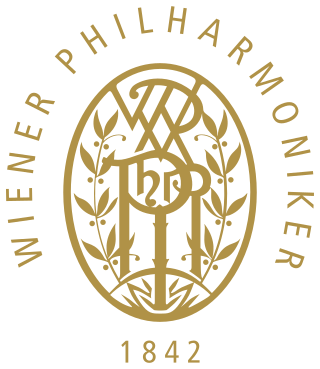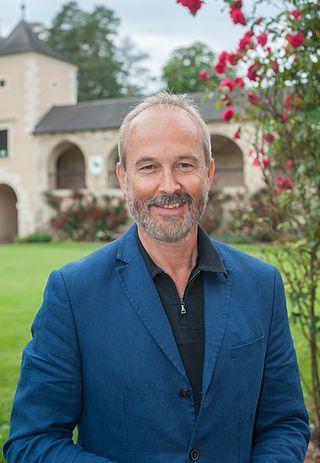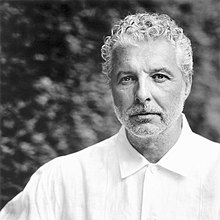Biography
Heller was born in Vienna into a wealthy Jewish family of sweets manufacturers, Gustav & Wilhelm Heller. His parents were Stephan Heller (1895–1958) and Elisabeth Heller (1914–2018). He visited Café Hawelka almost daily. It was in this coffeehouse that he met many men of letters including Friedrich Torberg, H. C. Artmann, and occasionally Elias Canetti, as well as Hans Weigel, and Helmut Qualtinger, with whom he later on collaborated and performed. He took acting classes from Hans Weigel and his cohabitee Elfriede Ott.
Theatre, radio, television, songs
Heller has been writing prose, poetry, and songs since 1964. He left school shortly before obtaining the Matura, (he went to a Jesuit boarding school). From 1965 to 1967, he was a moderately successful actor at various Viennese avant-garde theatres.
In 1967, Heller co-founded Ö3, the ORF's then-progressive pop music station, where he was one of the hosts of the daily Musicbox programme. That same year, he recorded his first LP record with the title Nr1 that was released in 1970. [2] His second LP called, Platte was released in 1971, and, subsequently, his first play premiered entitled, King-Kong-King-Mayer–Mayer–Ling at Vienna Festival in 1972. [3]
Chansonnier
As a poet songwriter, his work spans across a period of more than 15 years selecting diverse topics and writing for a German-speaking audience. He has worked with not only international names such as Ástor Piazzolla, Dino Saluzzi, and Freddie Hubbard, but also with Austrian artists such as Toni Stricker, Wolfgang Ambros, and Helmut Qualtinger. Heller's own poetry has been set to music. He has also sung texts by other authors. For instance, "Catherine", from 1970, was set to one of the first hits of Heller. The text came from the then still largely unknown Reinhard Mey, and the music from the Austro-Canadian Jack Grunsky. [4] With Werner Schneyder, he created Viennese German songs that are translated from Jacques Brel, such as "Franz" (after the Brel title "Jef"). Using intimate memories of traumatic childhood experiences, and insights into his life, as well as his Catholic-Jewish origin, he created songs with the title "Angstlied" (Verwunschen, 1980). [5] Titles like "Miruna, die Riesin von Göteborg" (Verwunschen, 1980) are, in turn, influenced by the Vienna School of Fantastic Realism. "Das Lied vom idealen Park" (Narrenlieder 1985), or, as a duet with Wolfgang Ambros, he also introduced the Bob Dylan cover, "Für immer jung" (Stimmenhören, 1983), [6] are now titles that are part of the Austro-pop cannon. In 1983, he appeared on Stimmenhören with the song "Erhebet euch Geliebte", a song at the time of the peace movement in the early 1980s. Since the early 1980s, he turned increasingly to large public productions, installations and performances, until 1982, where his concert career came to close. In 1985, the album, Narrenlieder, was released. Between 1967 and 1985, he published a total of fourteen LPs, twelve of those were gold records, and earned him seven times platinum. In 1991, he wrote, looking back on this period:
I started in 1967, to put my poems together using my voice on record and in recitals before millions of people. This was following the example of Bob Dylan's first meaningful and self-published poetry ... 1982 was certainly the zenith of that career, where I had to stop my concerts. I realized at this point, it was spoiled for me, because at 8 pm, I had to act gifted in front of a few thousand listeners, just because they had paid for admission. – Heller in the liner notes of Kritische Gesamtausgabe published in 1991.
However, on his 60th birthday, Heller gave a concert in April 2007 at the Viennese Radiokulturhaus, after twenty-five years of absence from the stage in a recital entitled, Konzert für mich (Concert for me). [7]
Between 1968 and 1983, Heller recorded 15 albums as a singer of his own texts, and in part of his own compositions. He was on the road with 9 international concert tours, and was the host and entertainer in 12 evening-filling TV shows.
In 2006, thanks to the initiative of Chris Gelbmann, he released his last album called, Ruf und Echo. [8] The 3-CD compendium is the first release in the past 20 years, containing new songs, and interpretations of old hits by artists like Brian Eno, Xavier Naidoo, Thomas D, and The Walkabouts.
Cultural manager
Heller was appointed as an Artistic Director of the Artistic and Cultural Programme that ran parallel to the 2006 FIFA World Cup in Germany. His company, Artevent, [9] was also responsible for the presentation of the Germany bid for the 2006 FIFA World Cup project. He designed the final presentation in 2000 for the successful West German application, and, in 2003, designed a "Fußball-Globus", an architectural project consisting of a huge lit-up football globe that toured through Germany standing in public places such as Brandenburg Gate in Berlin. Heller invented the motto for the Football World Cup, Die Welt zu Gast bei Freunden (A time to make friends).
For the World Cup, Heller planned an opening gala in Berlin's Olympic Stadium, where Brian Eno, and Peter Gabriel would be involved. On 13 January 2006, it was canceled by FIFA. The reason cited was that the turf, which would have been re-installed after the end of the gala, would not be in perfect condition for the first game there.
Since 2003, Robert Hofferer is his manager, and leads the firm Artevent, with headquarters in Vienna.
Actor
From 1976 until 1981, Heller played major roles in various international movies.
In the late 1960s, Heller joined as a financier in the film, Moos auf den Steinen , with Erika Pluhar in one of the main roles, for which he claims to have used up his inheritance. It was not long before he was in front the camera as an actor: Heller played roles in Hans-Jürgen Syberberg's Hitler: A Film from Germany , in Fear Not, Jacob! [ de ] by Radu Gabrea, in Doktor Faustus by Franz Seitz, and in Peter Schamoni's Frühlingssinfonie , in Maximilian Schell's 1979 film, Geschichten aus dem Wienerwald , which is based on Ödön von Horváth's play. In 1969, Heller participated in a televised version of Arthur Schnitzler's tragicomedy, Das weite Land [ de ], directed by Peter Beauvais. In 1989, he also worked as a stamp artist; on behalf of the United Nations Postal Administration, he designed a stamp to commemorate UN Vienna's tenth anniversary.
Publications
Heller has received numerous international awards. He has to date written 14 printed publications, among them are collections of stories Die Ernte der Schlaflosigkeit in Wien, Auf und Davon, Schlamassel, and Als ich ein Hund war, the novel Schattentaucher, and the collection of poems Sitzt ana und glaubt, er is zwa (with Helmut Qualtinger), as well as two picture books Jagmandir – Traum und Wirklichkeit, and Die Zaubergärten des André Heller. 21 TV documentaries have been produced about Heller's projects, productions, and plans. These were done by the likes of Werner Herzog, Syberberg, and Elsa Klensch, among others.
Private life
Heller was married from 1970 to 1984 to the actress, singer, and author Erika Pluhar. For some years, he lived in the 1970s with the actress Gertraud Jesserer, and much later, with the actress Andrea Eckert. Heller was romantically involved for short periods in the mid-1980s with Anke Kesselaar, Rudi Carrell's former wife.
Heller lives in an apartment in the Palais Windisch-Graetz [ de ] in Vienna's Innere Stadt quarter [10] that is owned by the Augustinian monastery of Klosterneuburg. In 2000, Heller received, there, the then German Chancellor Gerhard Schröder. Heller lives temporarily in the Giardino Botanico in Gardone Riviera. He currently lives with the former model Albina Schmid in Vienna, and travels the world. He has one son, Ferdinand, who goes under the stage name "Left Boy" for his music.

Vienna Philharmonic is an orchestra that was founded in 1842 and is considered to be one of the finest in the world.

The Austrian Football Association is the governing body of football in Austria. It organises the football league, Austrian Bundesliga, the Austrian Cup and the Austria national football team, as well as its female equivalent. It is based in the capital, Vienna.

The Academy of Fine Arts Vienna is a public art school in Vienna, Austria.

Helmut Berger was an Austrian actor, known for his portrayal of narcissistic and sexually ambiguous characters. He was one of the stars of European cinema in the late 1960s and 1970s, and is regarded as a sex symbol and pop icon of that period.

Helmut Gustav Friedrich Qualtinger was an Austrian actor, cabaret performer, writer and reciter.

Wattens is a market town of the Innsbruck-Land District in the Austrian state of Tyrol. It is chiefly known as home of the Swarovski crystal glass company.

Erwin Wurm is an Austrian artist. He lives and works in Vienna and Limberg in Austria; Hydra, Greece; and in New York City.

Gerhard Bronner was an Austrian composer, writer, musician and a cabaret artist, known for his contribution to Austrian culture in the post-World War II period.

Michael Streiter is an Austrian former football player and coach.

The Wienbibliothek im Rathaus, formerly known as the Wiener Stadt- und Landesbibliothek, is a library and archive containing important documents related to the history of Vienna, Austria. Founded in 1856, the library, which also contains a large collection of local memorabilia, is located in the Rathaus in the Innere Stadt first district of the city, and is the official library of the city and state of Vienna.

Helmut Ditsch is an Argentine painter. Ditsch's work focuses on extreme natural phenomena such as mountains, desert, ice, and water.
Jim Whiting is a British artist and inventor. He was born in Paris and spent his early childhood in Salisbury, Zimbabwe before returning to the UK with his family in 1959. He studied Electronic Engineering & Systems Control at Queen Mary College and then sculpture at Saint Martins School of Art after a foundation at High Wycombe Art College.
Hugo Markl is a contemporary American artist, curator, and creative director. He studied Visual communication at the University of Applied Arts Vienna (1985–90) where he graduated with an M.A. in fine arts. His practice spans a broad range of media including sculpture, photography, video, drawing, printmaking, installation art, and performance. Markl lives in New York City.

Tales from the Vienna Woods is a 1979 Austrian-German drama film directed by Maximilian Schell. The film was adapted from the play by Ödön von Horvath. It was selected as the Austrian entry for the Best Foreign Language Film at the 52nd Academy Awards, but was not accepted as a nominee. It was the final film for veteran actress Lil Dagover who started her film career in the 1910s.

Swarovski Kristallwelten is an experience attraction created by André Heller for the crystal glass manufacturer Swarovski, consisting of a park, art museum, retail area, and restaurant. It opened in 1995 and is located in the Austrian Tyrol, in the town of Wattens, Innsbruck-Land District, where the company was founded and still has its headquarters today. Kristallwelten, together with the Swarovski Kristallwelten Store in Innsbruck and Vienna, form D. Swarovski Tourism Services GmbH.
Andreas Neufert is a German art historian.
Tales from the Vienna Woods is a play by Austro-Hungarian writer Ödön von Horváth.

Harald Sokal is an Austrian jazz saxophonist.
Karl Grell was an Austrian composer and conductor.
Andre Asriel was an Austrian-German composer.














